Lately, there’s been increased interest in wearing boutonnieres, which are also known as lapel flower pins. People want to know the correct way to wear them, the types of jackets ideal for boutonnieres, and the specific placement to avoid common mistakes that make them look awkward.
This guide explains how to put on a boutonniere, how to attach it, and what to do if a jacket lacks a buttonhole or has one sewn shut. Whether a wearer prefers real or silk flowers, these tips will help you enjoy this classic accessory.
Ready to look sharp with a boutonniere?
Brief History of the Boutonniere
While there are various theories, including the famous story about Prince Albert inventing the lapel buttonhole to hold flowers from Queen Victoria as a romantic gesture on their wedding day, evidence suggests otherwise. Historical records, like his wedding portrait, show no indication of this practice.
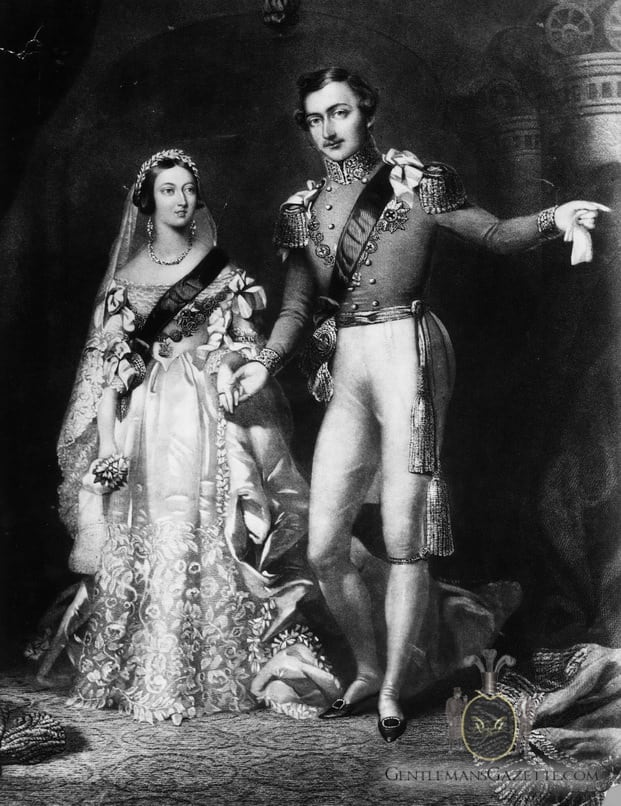
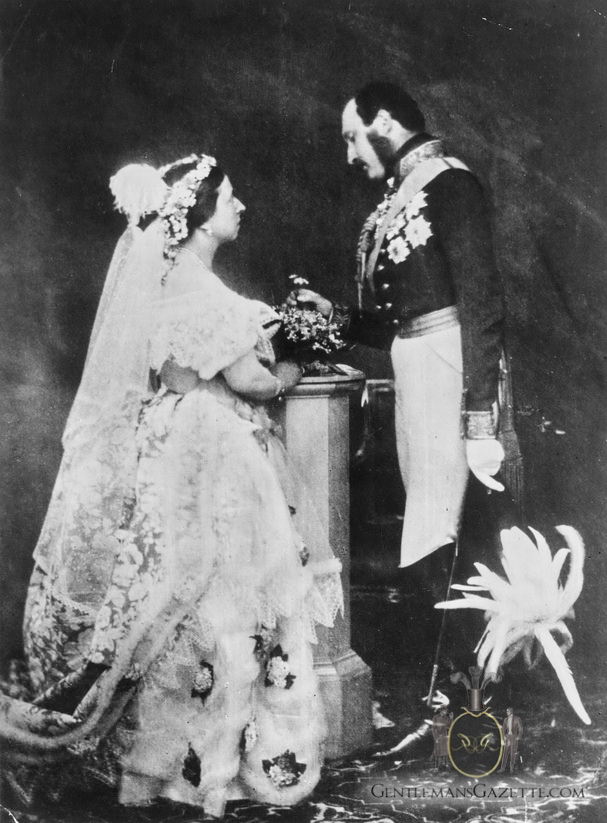
Others say that the boutonniere’s origins date back to the 15th century as a good luck charm for a knight. However, the first concrete evidence appears in a 1771 Gainsborough painting, showcasing a flower worn in a jacket’s buttonhole.

Interestingly, this predates the traditional lapel; jackets then were buttoned high, eventually contributing to the lapel’s design as we know it.
Learn the full history here!

Don’t pin a boutonniere directly onto your lapel
Whether real or not, pinning a boutonniere directly onto your lapel compromises the elegance of your look and risks damaging the fabric.
It also looks odd, especially with a shiny metal part reflecting the light. People are more prone to look at your flower than at your face.
The proper placement is to always put the stem through your jacket’s left lapel buttonhole.
How to Put a Boutonniere Into Your Jacket (Traditional Way)
Now that we’ve established the core rule, let’s dive into how to wear a boutonniere correctly. The first step is all about your jacket’s buttonhole:
Step #1: Check for a Buttonhole (Or Get One Added)
Ideally, your jacket will have a functional buttonhole. This is the traditional and preferred way to wear a boutonniere.

But, What if your jacket
Has NO Buttonhole?
If your jacket doesn’t have a buttonhole, visit an alterations tailor to have one added. This preserves the integrity of your jacket and upholds the classic style.
Many jackets come with a sewn-shut buttonhole. However, you can open it (carefully) by locating the buttonhole and using a small, sharp tool. It can be a pocket knife, box cutter, or a sharp razor blade to make a small, gentle cut to open the stitching. Make sure not to damage the seam or surrounding threads.


Once you have an open buttonhole on your jacket, simply insert the boutonniere stem through it. The procedure is the same for real and silk flowers.
Step #2: Use a Boutonniere Loop Stem Keeper or a Safety Pin
A stem keeper (a tiny loop at the back of the lapel) is a must-have to prevent your boutonniere from drooping or looking messy. It keeps everything secure and polished.

If your jacket doesn’t already have a stem keeper on the underside of your lapel, you can easily make one. However, if you don’t have time to make your stem keeper and you need a solution right away, get a simple safety pin.
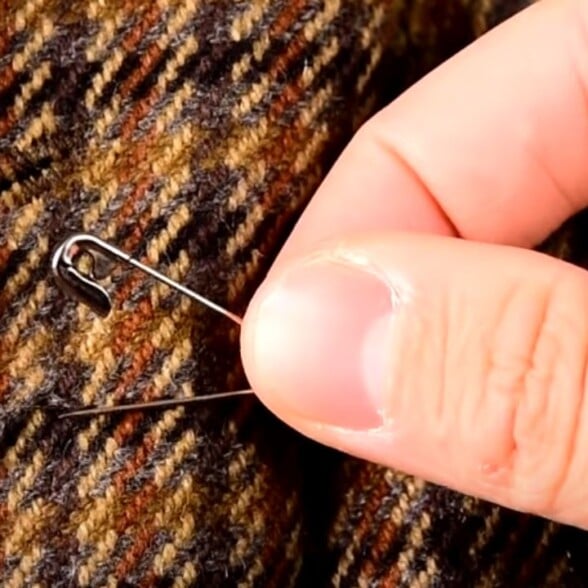
Tip for a quick fix
The Safety Pin
The safety pin has the same function as a stem keeper. Just open the safety pin and carefully pin it through the back of your lapel. Make sure it doesn’t peek out in the front.
This is a quick and inexpensive fix that works in any jacket!
Step #3: Insert the Boutonniere Flower
Once you’ve prepared your jacket, you can then slide your boutonniere stem through the buttonhole and keep the stem secure using either the boutonniere loop or the alternative closed safety pin. Nobody will see it from the front and you can easily remove it later.
Here are some examples of how to wear a boutonniere on a jacket with different colors and patterns:
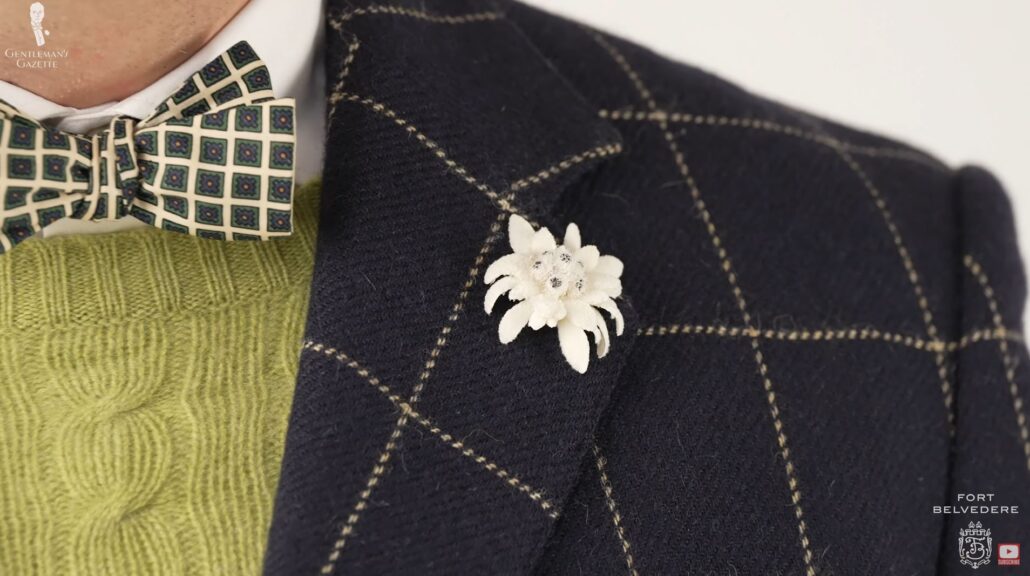

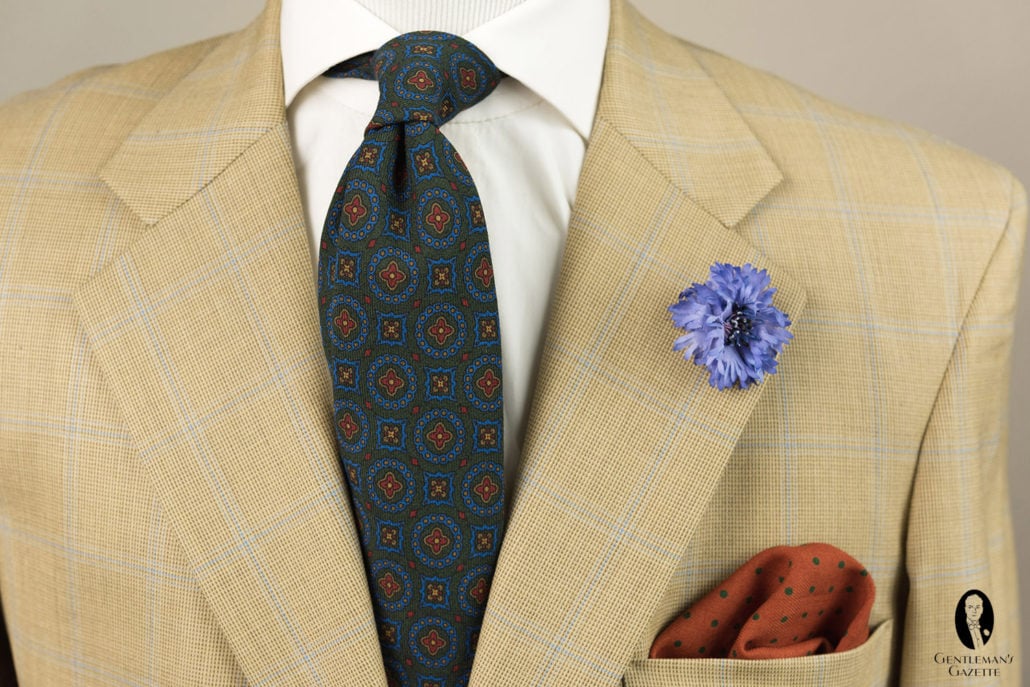
Ever wondered how boutonnieres are created?
Choosing the Right Boutonniere
The right boutonniere adds a final touch of refinement to your classic wardrobe. Let’s explore how to choose the perfect boutonniere to match the occasion while upholding timeless elegance.
Fresh or Silk Boutonniere Flowers – Which is Better?
The first step in selecting the perfect boutonniere is deciding on the type of flower. Are fresh flowers or the enduring beauty of silk the better choice for your boutonniere? Let’s weigh the options.
Fresh flowers
The quintessential choice for discerning gentlemen, fresh flowers offer a touch of elegance and vibrancy. Popular options include roses, orchids, lilies, and carnations. However, there are some drawbacks to consider.
Fresh flowers can be challenging to find exactly what you’re looking for. The flower stems might be too thick for a lapel, and most importantly, they wilt and stain your dress shirt or suit jacket.

Silk flowers
While fresh flowers have their traditional charm, silk flowers present compelling reasons to favor silk boutonnieres:
- Durability: Silk boutonnieres remain pristine throughout a long event, with no worries about wilting or staining, making them ideal for long events or travel. This is especially important for landmark events like weddings, proms, or graduations.
- Wider Variety: Silk flowers are available in a vast array of colors and styles and can even mimic the look of exotic blooms that might not be readily available.
- Lower Maintenance: Unlike fresh flowers, silk boutonnieres require no watering or special care.
- Realistic Look: High-quality silk flowers, like the ones created here in Gentleman’s Gazette, look very realistic. We use special techniques to achieve natural coloring and size down flowers that would be too large for a lapel.

Fort Belvedere
Edelweiss Boutonniere

Fort Belvedere
Red Spray Rose Boutonniere
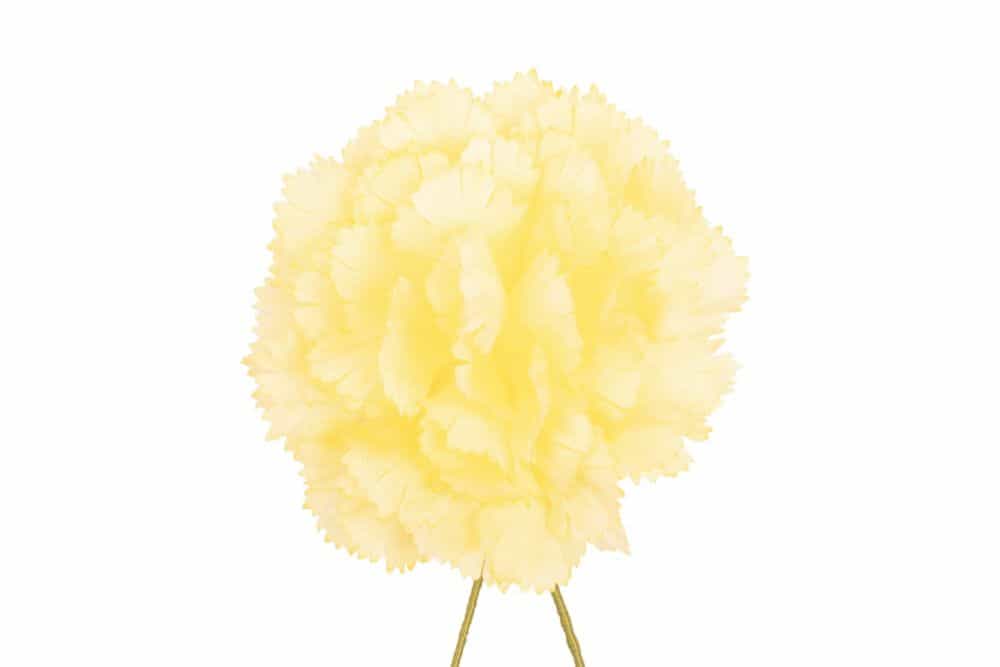
Fort Belvedere
Yellow Mini Carnation Silk Boutonniere
Although silk flowers offer significant advantages, they also have drawbacks. Less-expensive silk flowers made with cheap fabrics show unrealistic details identifiable even from a distance. Furthermore, they may lack the vast color and size variety found in natural blooms.
Finally, creating high-quality, realistic silk flowers requires significant craftsmanship, which can sometimes lead to a higher price tag compared to simpler silk options.
So, which is better? Fresh or silk boutonnieres? Considering all of that, while quality silk flowers may have a slightly higher initial cost, their enduring beauty, versatility, and ease of use make them a superior value overall.
The true meaning of flowers, revealed!
How to Style a Boutonniere for Different Events (Formal & Semi-formal)
Here are some key factors to consider when choosing your boutonniere:

Formal Events (Wedding, Gala)
Formal events like weddings or galas call for more elaborate boutonnieres in your formalwear. Consider incorporating the event’s color scheme into your boutonniere selection for weddings. Alternatively, a single, classic rosebud might be an ideal choice for a business meeting.
Did You Know? While the groom and groomsmen typically wear distinct boutonnieres, other wedding guests are welcome to add this touch of refinement as well. Just make sure that your boutonniere is not overly showy, bold, or large, as this touch often indicates a member of the wedding party.
Semi-Formal (Prom, Graduation)
Vibrant silk carnations, small clusters of your favorite blooms, or unique textures add distinctive flair while maintaining a classic style. Don’t be afraid to express yourself!
Some ideas include single carnations in vibrant or understated colors; small floral clusters featuring your favorite blooms; and unique silk boutonnieres with interesting textures or unexpected colors.
Important Note
The color and style of your suit should influence your boutonniere selection. A bold-colored flower might overpower a light-colored suit, while more muted boutonniere flowers might complement a patterned jacket.
Moreover, you should pay attention to the proportion of the lapel and the flower when selecting your boutonniere. It should be in scale with the lapel of your jacket. Opt for smaller flowers for a balanced look, as a large flower head on a narrow lapel will look out of place.
Find your ideal boutonniere – explore styles & tips.
Modern Adaptations (With a Caveat)
Today, contemporary trends and a decline in jackets with traditional buttonholes have led many to latch their boutonnieres directly to the fabric using 1 or 2 pins.
However, it’s important to be aware of the drawbacks of direct pinning. As mentioned previously, this method often damages delicate fabrics and compromises the elegance of the overall look.

Plus, the visible pin detracts from the beauty of the flower and creates an informal aesthetic. While you can creatively adapt a boutonniere directly to dress shirts, vests, suits, blazers, and pocket squares and sometimes see them pinned to hat brims or ties, it is not considered classically “correct.”
Remember, these placements deviate from the classic approach and are often more difficult to secure neatly than a lapel buttonhole. But when left with no choice, always use caution with pins to avoid causing accidental injury.
So, what is classic style for men…and what isn’t?
Ready to Elevate Your Style?
Whether you’re a guest, heading to a wedding or a prom, or want to add polish to your everyday look, the boutonniére is a timeless touch.
Remember, always start with a functional buttonhole, add a stem keeper for a polished finish, and don’t be afraid to express your personality through your choice of flower and style.
Want more style guidance beyond the boutonniere? Sign up for our free newsletter and receive the “Gentlemen of Style” ebook to discover color-pairing secrets and build a wardrobe that makes you feel confident and stylish.
FAQs on How to Put a Boutonniere On
Are boutonnieres out of style for weddings?
Absolutely not! While their popularity may ebb and flow, the boutonniere remains a timeless symbol of celebration and distinction for weddings. It adds a refined touch to formal attire, especially for those with significant roles like the groom, groomsmen, and fathers of the couple.
How high should boutonniere be?
Traditionally, the boutonniere rests on the left lapel, aligning with the chest’s widest point. The stem should point downward. This placement ensures both elegance and practicality, keeping the flower secure.
Can I wear a boutonniere on a shirt without a lapel?
While boutonnieres are classically designed for jacket lapels, you can adapt the look for a shirt with some creativity. Remember that this deviates from the classic approach and offers a more contemporary and casual take on the boutonniere.
You may choose a very lightweight boutonniere or a small single bloom to avoid pulling down the fabric of your shirt. If your shirt has a breast pocket, you could pin the boutonniere carefully to the top of the pocket seam, which offers some reinforcement.
What side does the boutonniere go on? Left side or right side?
The boutonniere is always worn on the left lapel.
Why does the boutonniere go on the left?
Historically, the left lapel was the practical choice for men carrying swords (worn on the left hip for right-handed individuals) to avoid snagging or entanglement. Today, while less about practicality, the tradition remains.
Which way should the flower face?
The flower should face outward.
How many main flowers are usually used to create a boutonniere?
Classically, a single, striking bloom forms the focal point of a boutonniere. However, modern interpretations may incorporate a small cluster of complementary flowers or leaves for added texture and visual interest.
How long will a fresh flower boutonniere last?
Depending on the specific flower variety, fresh boutonnieres typically last several hours to a full day.
What is the difference between a boutonniere and a corsage?
Men wear a boutonniere, while a corsage is a floral accessory typically worn by women.
How can a groom wear a boutonniere without damaging a rented tuxedo by piercing a hole in the lapel?
Some contemporary tuxedos, especially those with shawl lapels, may lack the traditional buttonhole. Before the event, confirm with the rental company whether the tuxedo has a buttonhole. Using it will be the most classic and secure option if it does.
Otherwise, inquire with your florist about the best options for your rented attire. Magnetic fastenings that are less likely to cause damage to delicate fabrics might be recommended by the florist.
Can you wear a boutonniere on a vest?
While a vest can offer a charming location for a boutonniere, the classic and most elegant approach is to place the stem through your jacket’s lapel buttonhole. This modern practice of pinning directly onto the vest deviates from the traditional rules of formal attire.
However, you can position the boutonniere centrally, just above the pocket, for a balanced look on a vest. While less traditional, this placement offers a contemporary touch.
How much is a typical boutonniere?
The cost of a boutonniere may vary depending on several factors. However, for a beautifully crafted, high-quality boutonniere, such as the ones offered here at Fort Belvedere, you can expect to invest $45 per piece.
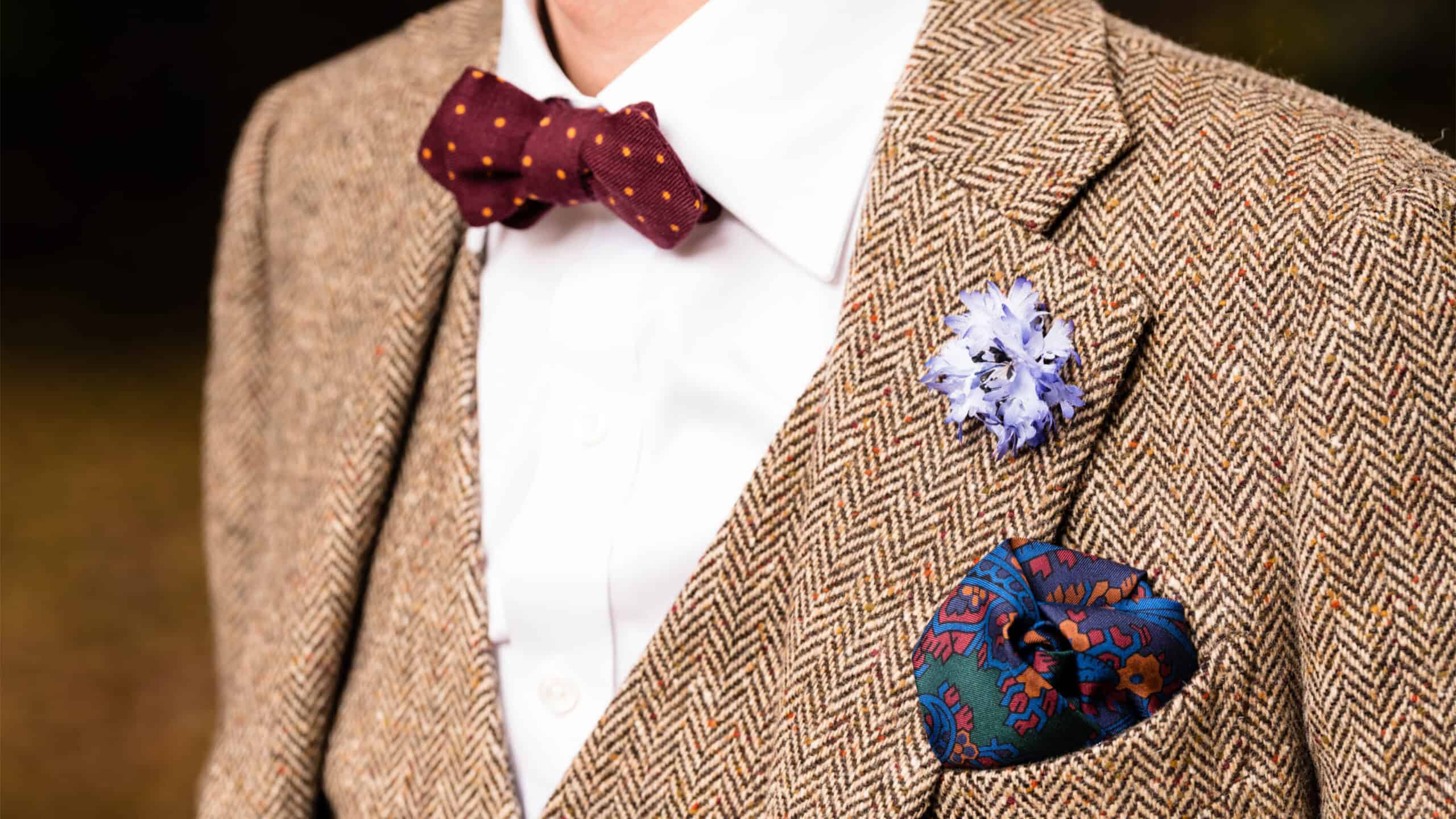

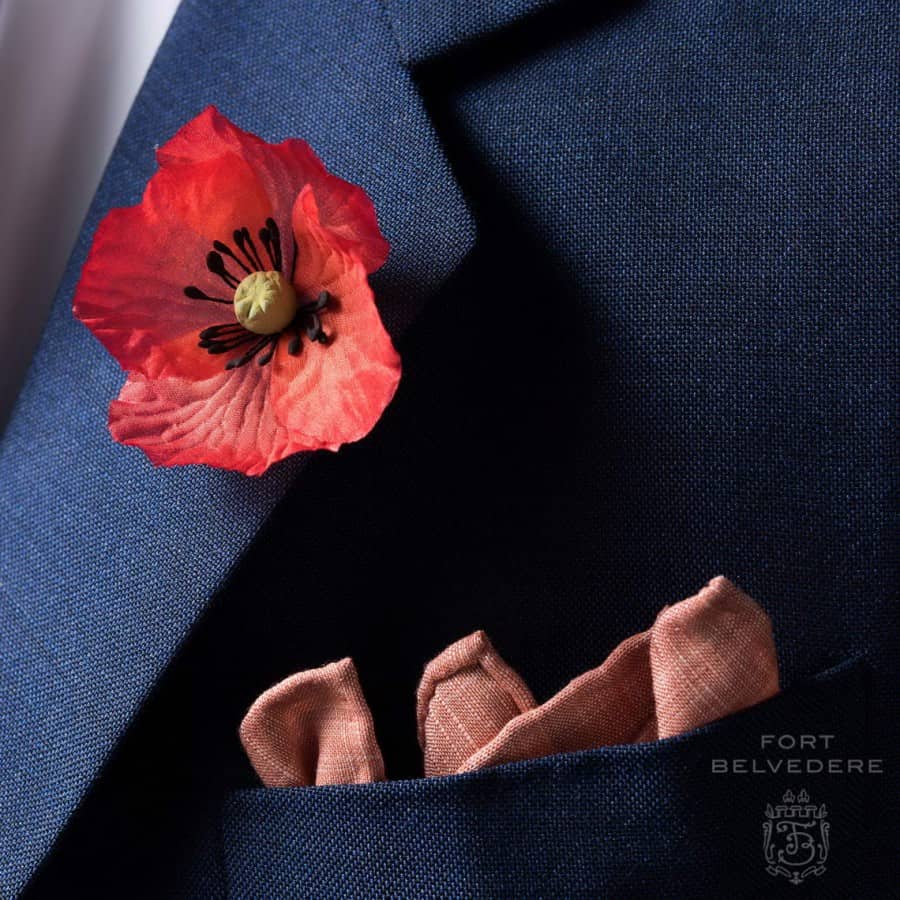


Thanks Raphael. It would be nice to see a tutorial on how to prepare a live flower for a boutonniere.
How to prepare a live flower to act as a boutiniere? In my personal 1st hand experience, the flower shop that fashioned the live flower pedal for me, supplied a ‘pearl’ tiped stick pin. Presumably they provide flower boutiniere’s for prom, wedding, formal events. You position your flower on your lapel (in the correct area!) and you PIN it to the lapel, so that the pin (the shiny part) doesn’t show through. Viola! You’re sartorially in business, looking sauve & well put together.
The video was a nice effort, but I found some of the ‘advice’ … a bit amusing, not negatively so, just amusing …
AJ, each to his own, but pinning flowers to one’s lapel looks cheap, and in 90% of the time the flower arrangements are way too big. Over the course of the day, they dangle, and the”pearl” you are talking of is simply plastic ;).
Looks cheap!? Not so! … not in my case! Quite elegant! The flower wasn’t too big. As I said, the flower shop person was experienced in providing the bouquet. The flower didn’t droop, in fact it stayed fresh for about a week! I wore it to special religious event and its appearance was stunning & elegant! The ‘pearl’ was plastic … but you pin it to be hidden, not to show! I don’t consider myself a neophyte dresser, IMHO. I know the “rules” Been at the clothing game, since the age of 12, 13. I have an anniversary next month! I turn 58! …yes, each to one’s ‘stylish & knowledgeable’ own! ;-)). Peace.
My question is about making boutonnieres that are intended to be inserted into the button hole and secured with the loop behind the lapel. I don’t intend to stick-pin anything to my lapel.
….re: “not sticking a pin in lapel” …. to each his own!! … don’t do it. The advice given below holds true and is spot on. Take it slow & have fun experimenting! Peace.
Tony,
that depends on every flower. Some you can just put through. the problem sometimes happens when you bend the stem, because they break. Carnations on the other hand and other more delicate flowers need a wrapped stem. Today, you find hardly any florists who properly make boutonnieres. The boutonnieres you usually get don’t have anything to do with the proper old school way. The best instruction is provided in this book.
Hi Raphael, thanks for understanding what I’m getting at :-) Basically, I want to use natural flowers to create the neat look that your artificial flowers have–that is, the flower stems should face forward rather than upward. This does require bending the stem 90 degrees.
I have that book. There’s one section about a London flower shop that prepare boutonnieres the old fashioned way but it doesn’t contain any specific instructions. It does say that the resulting product is a highly artificial construct. Some of the steps involved are hinted at: the flower needs to be trimmed to the right size, the stem ought to be reinforced using wire and wrapped in florist tape. And in one picture it seems that the back of the flower is covered with a piece of cardboard–perhaps to prevent it from soiling the jacket?
I plan to try making some boutonnieres on my own.
I suggest, you just start doing it and let us know how that goes. I’d start with less expensive flowers do you don’t burn too much money. Carnation boutonnieres are often sewn together just from the petals, others glue them together. It’s a lot of work for one flower that will be discarded afterwards. Depending on your hourly rate it may or may not be worth the time, but I encourage you to give it a try.
Great information and video, as always. Thanks! Just a heads up, the sensor on your camera could possibly use a cleaning; I noticed some dust spots in the upper right quadrant of the frame.
Paul, those weren’t dust spots but background spots ;). Thanks nonetheless.
Hi Raphael,
Thanks for your nice video on boutonnière. I would like to know if I could wear it also under a coat. Doesn’t a coat damage a three dimensional boutonnière?